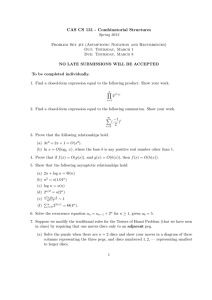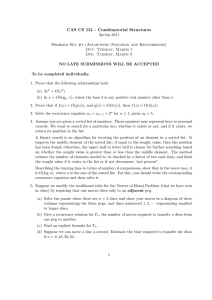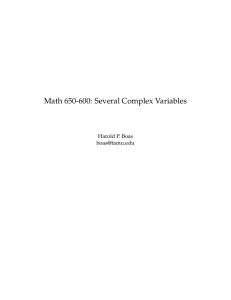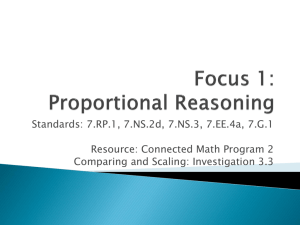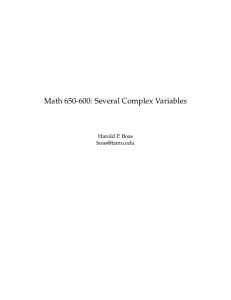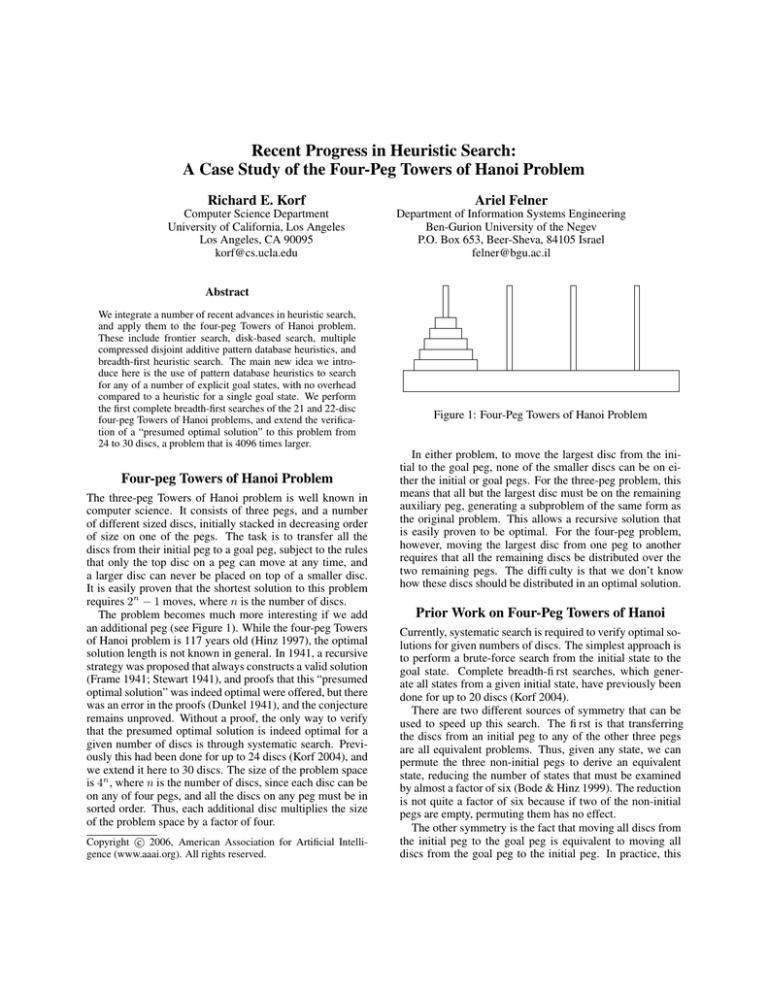
Recent Progress in Heuristic Search:
A Case Study of the Four-Peg Towers of Hanoi Problem
Richard E. Korf
Ariel Felner
Computer Science Department
University of California, Los Angeles
Los Angeles, CA 90095
korf@cs.ucla.edu
Department of Information Systems Engineering
Ben-Gurion University of the Negev
P.O. Box 653, Beer-Sheva, 84105 Israel
felner@bgu.ac.il
Abstract
We integrate a number of recent advances in heuristic search,
and apply them to the four-peg Towers of Hanoi problem.
These include frontier search, disk-based search, multiple
compressed disjoint additive pattern database heuristics, and
breadth-first heuristic search. The main new idea we introduce here is the use of pattern database heuristics to search
for any of a number of explicit goal states, with no overhead
compared to a heuristic for a single goal state. We perform
the first complete breadth-first searches of the 21 and 22-disc
four-peg Towers of Hanoi problems, and extend the verification of a “presumed optimal solution” to this problem from
24 to 30 discs, a problem that is 4096 times larger.
Four-peg Towers of Hanoi Problem
The three-peg Towers of Hanoi problem is well known in
computer science. It consists of three pegs, and a number
of different sized discs, initially stacked in decreasing order
of size on one of the pegs. The task is to transfer all the
discs from their initial peg to a goal peg, subject to the rules
that only the top disc on a peg can move at any time, and
a larger disc can never be placed on top of a smaller disc.
It is easily proven that the shortest solution to this problem
requires 2n − 1 moves, where n is the number of discs.
The problem becomes much more interesting if we add
an additional peg (see Figure 1). While the four-peg Towers
of Hanoi problem is 117 years old (Hinz 1997), the optimal
solution length is not known in general. In 1941, a recursive
strategy was proposed that always constructs a valid solution
(Frame 1941; Stewart 1941), and proofs that this “presumed
optimal solution” was indeed optimal were offered, but there
was an error in the proofs (Dunkel 1941), and the conjecture
remains unproved. Without a proof, the only way to verify
that the presumed optimal solution is indeed optimal for a
given number of discs is through systematic search. Previously this had been done for up to 24 discs (Korf 2004), and
we extend it here to 30 discs. The size of the problem space
is 4n , where n is the number of discs, since each disc can be
on any of four pegs, and all the discs on any peg must be in
sorted order. Thus, each additional disc multiplies the size
of the problem space by a factor of four.
c 2006, American Association for Artificial IntelliCopyright gence (www.aaai.org). All rights reserved.
Figure 1: Four-Peg Towers of Hanoi Problem
In either problem, to move the largest disc from the initial to the goal peg, none of the smaller discs can be on either the initial or goal pegs. For the three-peg problem, this
means that all but the largest disc must be on the remaining
auxiliary peg, generating a subproblem of the same form as
the original problem. This allows a recursive solution that
is easily proven to be optimal. For the four-peg problem,
however, moving the largest disc from one peg to another
requires that all the remaining discs be distributed over the
two remaining pegs. The diffi culty is that we don’t know
how these discs should be distributed in an optimal solution.
Prior Work on Four-Peg Towers of Hanoi
Currently, systematic search is required to verify optimal solutions for given numbers of discs. The simplest approach is
to perform a brute-force search from the initial state to the
goal state. Complete breadth-fi rst searches, which generate all states from a given initial state, have previously been
done for up to 20 discs (Korf 2004).
There are two different sources of symmetry that can be
used to speed up this search. The fi rst is that transferring
the discs from an initial peg to any of the other three pegs
are all equivalent problems. Thus, given any state, we can
permute the three non-initial pegs to derive an equivalent
state, reducing the number of states that must be examined
by almost a factor of six (Bode & Hinz 1999). The reduction
is not quite a factor of six because if two of the non-initial
pegs are empty, permuting them has no effect.
The other symmetry is the fact that moving all discs from
the initial peg to the goal peg is equivalent to moving all
discs from the goal peg to the initial peg. In practice, this
cuts the effective search depth in half, as follows (Bode &
Hinz 1999). Assume that we fi nd a path to a state where
all discs but the largest are distributed over the two auxiliary
pegs. Call such a state a middle state. We can then move
the largest disc from the initial peg to the goal peg. If we
then execute all the moves made to reach the middle state
in reverse order, we will return all but the largest disc back
to the initial peg. If, however, while executing these moves
we interchange the initial peg with the goal peg, we will
move all but the largest disc to the goal peg, completing the
solution. Thus, once we reach a middle state, we can easily
generate a complete solution, and once we fi nd a shortest
path to a middle state, we have found a shortest solution
path. We refer to such a search as a half-depth search.
(Korf 2004) used both these symmetries in a brute-force
half-depth search, verifying the presumed optimal solution
length for up to 24 discs. Two additional techniques used in
that work, frontier search (Korf et al. 2005), and storing the
nodes on magnetic disk1 , are discussed below.
Verifying the optimal solution length for more discs requires a heuristic rather than a brute-force search. Previously, the largest four-peg Towers of Hanoi problem that
had been solved optimally with heuristic search was 19 discs
(Zhou & Hansen 2006). This is much smaller than the 24disc problem solved with brute-force half-depth search, because the heuristic search was a full-depth search, computing the heuristic function to the single goal state.
The main new idea in this paper is to show how to compute a heuristic that estimates the length of a shortest path to
any of a large number of different states. This allows us to
combine heuristic search with half-depth searches, by estimating the length of a shortest path to any middle state. The
naive approach of computing a heuristic estimate of the distance to each middle state, and taking the minimum of these
values for each state of the search, is obviously impractical
when the number of middle states is large. For the n-disc,
four-peg Towers of Hanoi problem, there are 2n−1 possible
middle states, one for each way to distribute the n − 1 smallest discs over the two auxiliary pegs.
Pattern Database Heuristics
Pattern databases are heuristic functions based on lookup tables stored in memory (Culberson & Schaeffer 1998), and
are the most effective heuristics known for many problems,
including Rubik’s cube (Korf 1997) and the sliding-tile puzzles (Korf & Felner 2002). A pattern database for the Towers
of Hanoi problem contains an entry for each possible confi guration of a subset of the discs, the pattern discs. The value
of each entry is the number of moves required to move the
pattern discs to the goal peg, ignoring any other discs in the
problem (Felner, Korf, & Hanan 2004). Given a problem
instance, for each state of the search, we use the confi guration of the pattern discs to compute an index into the pattern
database. The corresponding stored value is then used as
a lower-bound heuristic on the number of moves needed to
move all the discs to the goal peg.
1
Throughout this paper we use “disc” to refer to a Tower of
Hanoi disc, and “disk” to refer to a magnetic storage disk.
The size of a pattern database is limited by the memory
available, and is a function of the number of pattern discs.
For any confi guration of n discs, we can compute a unique
index in the range 0 to 4n − 1 by encoding the peg that each
disc is on with two bits, and using the resulting binary number of 2n bits as the index. Thus, we only need to store the
heuristic values and not the corresponding states in the pattern database. If the values are less than 256, each value can
be stored in a byte of memory. Thus, a pattern database of
15 discs requires 415 = 230 bytes, or a gigabyte of memory.
To construct such a pattern database, we perform a
breadth-fi rst search starting with all 15 discs on the goal
peg. As each new confi guration of discs is fi rst encountered, we store the depth at which it is encountered in the
database. This search continues until all confi gurations have
been generated. A pattern database only needs to be constructed once, written to disk, and then reloaded to solve different problem instances. Furthermore, note that any set of
15 different-sized discs will generate exactly the same pattern database, regardless of their actual sizes.
Pattern databases have been used in full-depth heuristic
searches of the four-peg Towers of Hanoi problem with up
to 19 discs (Felner, Korf, & Hanan 2004; Felner et al. 2004;
Zhou & Hansen 2006). The main new idea in this paper is to
use pattern databases with multiple goal states, such as the
middle states in the Towers of Hanoi, for example.
Multiple-Goal Pattern Databases
Pattern databases are easily adapted to handle multiple goal
states. Rather than seeding the breadth-fi rst search queue
with a single goal state, we start with all the goal states in
the queue at depth zero. Thus, the depth of any state in such
a breadth-fi rst search is the length of a shortest path to any of
the goal states. While this may appear obvious in hindsight,
to our knowledge it has not been used nor published before.
For example, to construct a pattern database containing
the number of moves needed to move 15 discs to one of
two auxiliary pegs, we generate all 215 states in which the
15 discs are distributed among the two auxiliary pegs, and
assign each a value of zero in the database. These states
are used to initialize the breadth-fi rst search queue, and the
search runs until all possible confi gurations of the 15 discs
have been generated, recording their distances in the pattern database. Thus, for any state, the value in the pattern
database is the minimum number of moves needed to move
all the discs to one of the two auxiliary pegs.
While multiple-goal pattern databases is the main new
idea in this paper, optimally solving the 30-disc problem required integrating a signifi cant number of recent research
results in this area. We briefly discuss each of these in turn.
Frontier Search
The resource that limits both the breadth-fi rst search to generate pattern databases, and the heuristic search to verify the
presumed optimal solution lengths, is storage for the search
nodes. To reduce the number of nodes that must be stored,
we use frontier search (Korf et al. 2005). For simplicity, we
describe it in the context of breadth-fi rst search. Normally,
a breadth-fi rst search stores all the nodes generated in either
a Closed list of expanded nodes, or an Open list of nodes
generated but not yet expanded. A complete search of the
22-disc, four-peg Towers of Hanoi problem, would generate
422 or almost 17.6 trillion nodes. Frontier search only saves
the Open list, and not the Closed list, reducing the space required to the maximum number of nodes at any depth. In
addition, it saves with each node the operators used to generate it, to avoid regenerating the parent of a node as one of
its children. For a complete search of the 22-disc problem,
this is only 278 billion nodes, a reduction of over a factor
of 63. Additional work is required to generate the actual
solution path, but this adds only a small overhead to the algorithm. In our case there was no overhead, since we don’t
need the actual solution path, but simply the depth of a given
node, both to generate the pattern database, and to verify the
presumed optimal solution lengths.
Since all nodes in a given fi le have their largest discs in
the same position, any duplicate nodes are confi ned to the
same fi le, and duplicate merging of a fi le can be done independently of any other fi les. When expanding nodes in a
fi le, however, their children will belong in different fi les if
the large discs are moved. Furthermore, the expansion of
two different fi les can send children to the same fi le. Previous implementations of this algorithm (Korf 2003; 2004;
Korf & Shultze 2005) have coordinated multiple threads so
that fi les that can generate children that belong in the same
fi le are not expanded at the same time. In our current implementation, we remove this restriction so that two different
expansion threads may write children to the same fi le. In order to determine the size of the resulting fi le, we perform a
system call. This both simplifi es the code and also speeds it
up, since there is less coordination among multiple threads.
Handling Large Numbers of Files
Storing Nodes on Disk
Even with frontier search, however, 278 billion nodes is too
many to store in memory. The solution is to store the nodes
on magnetic disk (Korf 2003; 2004; Korf & Shultze 2005).
The fundamental challenge is to design algorithms that only
access the nodes on disk in a sequential fashion, since random access of data stored on disk is prohibitively expensive.
The main reason that nodes are stored is to detect duplicate nodes, which are nodes representing the same state arrived at via different paths. Nodes are normally stored in
a hash table, which is randomly accessed each time a new
node is generated to check for duplicate copies. When storing nodes on disk, however, newly generated nodes are not
checked immediately, but written out to fi les, and then duplicate nodes are merged later in a single sequential pass
through each fi le. When this delayed duplicate detection
is combined with frontier search in a problem such as the
Towers of Hanoi, two levels of a breadth-fi rst search must
be stored, rather than just one (Korf 2004).
This algorithm proceeds in alternating phases of node expansion and merging to eliminate duplicates. During expansion, fi les of parent nodes are expanded, and their children
are written to other fi les. All the nodes in a given fi le are at
the same depth, and have their largest discs in the same position. The position of the largest discs is encoded in the fi le
name, and hence the individual nodes in the fi le specify only
the positions of the smallest discs. In our implementation,
the positions of the smallest 14 discs are stored in the actual
records. This number is chosen because 14 discs require 28
bits, and 4 more bits are used for used operator bits, allowing
a single 32-bit word to represent a state.
Parallel Processing
Any algorithm that makes extensive use of fi le I/O should
be parallelized so that the CPU(s) can be occupied while
a process blocks waiting for I/O. In addition, dual processor systems and multiple-core CPUs are becoming increasingly common, offering further performance gains from parallelism. Our algorithm is multi-threaded, with different
threads expanding or merging different fi les in parallel.
Previous implementations of this algorithm (Korf 2003;
2004; Korf & Shultze 2005) have maintained in memory a
data structure containing information about each fi le, such
as its size. This is not practical with very large numbers of
fi les, however. For example, to verify the optimal solution to
the 30-disc problem, we need to store states with 29 discs, as
will be explained later. The positions of the 14 smallest discs
are stored with each node, and the positions of the remaining
15 discs are encoded in the fi le name. This requires keeping
track of over 2 × 415 /6 ≈ 358 million different fi les, since
we have separate expansion and merge fi les. Thus, storing
even the sizes of these fi les in memory is too expensive.
Instead, we store only two bits for each possible fi le, one
for the expansion fi le at the current depth, and the other for
the merge fi le at the next depth. If the corresponding fi le
exists, the bit is set to one, and zero otherwise. If the fi le
exists, then we perform a system call to determine its size.
Performing a system call on every possible fi le just to tell if
it exists is prohibitively expensive.
Since we only store one bit per fi le, we don’t keep track of
which expansion fi les have already been expanded, and thus
we can’t merge a fi le as soon as it is complete. Instead, we
do all the fi le expansions at a given depth, followed by all the
fi le merges. This further simplifi es and speeds up the code,
but at the cost of some additional disk space, since fi les are
not merged as soon as possible. As the results below will
show, however, time is a more constraining resource than
disk space at this point.
Compressed Pattern Databases
As a pattern database includes more components of a problem, the heuristic values become more accurate, since the
database reflects the interactions between the included components. In the case of the Towers of Hanoi, the more discs
that are included, the more accurate the heuristic. The limitation is the memory available to store the pattern database.
For example, a full pattern database based on the 22-disc
four-peg Towers of Hanoi problem would require 422 or
about 18 trillion entries. We can “compress” such a pattern database into a smaller database that will fi t in memory,
however, with only a modest lost of accuracy, as follows.
We generate the entire problem space of the 22-disc problem, in about 11 days. As each state is generated, we use
the confi guration of a subset of the discs, say the 15 largest,
as an index into a pattern database in memory, and store in
that database the shallowest depth at which that confi guration of 15 discs occurs. This is called a compressed pattern
database (Felner et al. 2004), and occupies only a gigabyte
of memory. Each entry corresponds to a particular confi guration of the 15 largest discs, but contains the minimum
number of moves required to move all 22 discs to their goal
peg, where the minimization is over all possible confi gurations of the remaining six smallest discs. Note that the values in this pattern database are signifi cantly larger than the
corresponding entries in a simple 15-disc pattern database,
because the latter values ignore any smaller discs.
To use this compressed pattern database in a search of a
problem with at least 22 discs, for each state we look up the
position of the 15 largest discs, and use the corresponding
table value as the heuristic for that state.
Disjoint Additive Pattern Databases
Assume we have a Towers of Hanoi problem with 29 discs,
and two different simple pattern databases, one for 15 discs
and one for 14 discs. Note that any move only moves a single disc. Thus, given any confi guration of the 29 discs, we
can divide them into two disjoint groups of 15 discs and 14
discs, look up the confi guration of each group in the corresponding pattern database, and sum the resulting values to
get an admissible heuristic value for the 29-disc problem.
Furthermore, any disjoint partition of the discs will work.
This is called a disjoint additive pattern database (Korf &
Felner 2002; Felner, Korf, & Hanan 2004).
Combining compressed and additive pattern databases is
straightforward. Again assume a problem with 29 discs, and
a 22-disc pattern database compressed to the size of a 15disc database. The compressed pattern database contains the
number of moves needed to solve the 22 discs. We can construct a separate pattern database for the seven remaining
discs, requiring only 47 or 32 kilobytes of memory. Then
given a state, we can use the 15 largest discs to represent the
22 largest discs, look up the corresponding entry in the compressed pattern database, then look up the confi guration of
the seven smallest discs in the seven-disc pattern database,
and fi nally add the two heuristic values together, to get an
admissible heuristic for all 29 discs.
Multiple Pattern Databases
In order to sum the values from two different pattern
databases, the corresponding sets of elements must be disjoint, and every move must move only a single element.
However, given any two admissible heuristic functions, their
maximum is usually a more accurate admissible heuristic. It
has been observed that the maximum of two or three different pattern database heuristics is often more accurate than
a single pattern database heuristic of the same total size,
and more than compensates for the overhead of the multiple lookups (Holte et al. 2004).
Continuing our example with 29 discs, we can construct
two different admissible heuristics as follows: One divides
the 29 discs into the 22 largest and seven smallest discs,
adding their pattern database values, and the other divides
them into the seven largest and 22 smallest discs, again
adding their database values. Finally, we take the maximum
of these two values as the overall heuristic value. We use the
same 22-disc database and 7-disc database for both heuristics, since the absolute sizes of the discs doesn’t matter.
Breadth-First Heuristic Search
Frontier search with delayed duplicate detection can be combined with a best-fi rst heuristic search such as A* (Hart,
Nilsson, & Raphael 1968), but the frontier of a best-fi rst
search includes nodes at different depths, and is usually
larger than a frontier of nodes all at the same depth. A better solution to this problem is an algorithm called breadthfi rst heuristic search (Zhou & Hansen 2006). Breadth-fi rst
heuristic search is given a cost threshold, and searches for
solutions whose cost does not exceed that threshold. The
search is a breadth-fi rst search, except that as each node is
generated, the cost of the path to the node, g(n), is added to
the heuristic estimate of the cost of reaching a goal from that
node, or h(n). If the cost of the node f (n) = g(n) + h(n)
exceeds the associated cost threshold, the node is deleted.
Breadth-fi rst heuristic search is a form of frontier search,
and only stores a few levels of the search at a time. Thus,
once a solution is found, additional work is required to construct the solution path. If the optimal solution cost is not
known in advance, a series of iterations can be performed
with successively increasing cost thresholds, until the optimal solution is found. This algorithm is called breadth-fi rst
iterative-deepening-A* (Zhou & Hansen 2006).
Breadth-fi rst heuristic search is ideally suited to our Towers of Hanoi problem for several reasons. One is that to verify the presumed optimal solution length, we don’t need to
construct the solution path, since these solutions are known.
Of course, if we were to fi nd a shorter solution, we would
want to generate it to verify that it is correct. Secondly, since
we know the presumed optimal solution length in advance,
we can set the cost threshold to this value, eliminating the
need for iterative deepening.
Minimizing Heuristic Calculations
For many search problems, the time to compute the heuristic evaluations is a signifi cant fraction of the running time.
This is particularly true with multiple heuristics, or for large
pattern databases that reside in main memory, since they are
randomly accessed, resulting in poor cache performance.
For pattern database heuristics, it is easy to determine
a maximum possible heuristic value, from the maximum
value in each database. For many search algorithms, such
as breadth-fi rst heuristic search or iterative-deepening-A*
(IDA*) (Korf 1985), pruning occurs by comparison to a
known cost threshold. Under these circumstances, we can
speed up a heuristic search by only computing heuristics for
nodes that could possibly be pruned. In particular, if t is
the cost threshold, and m is the maximum possible heuris-
tic value, then we need not compute any heuristics for those
nodes n for which g(n) + m ≤ t. To the best of our knowledge, this technique has not appeared in the literature before.
Brute-Force Search of Towers of Hanoi
We fi rst describe complete brute-force searches of the fourpeg Towers of Hanoi problem. These are used to compute
pattern databases, and are also of interest in this problem
for another reason. For the three-peg problem, the minimum
number of moves needed to transfer all n discs from one peg
to another is 2n−1 . Furthermore, if we perform a breadthfi rst search starting with all discs on a single peg, once the
search to depth 2n−1 is complete, all states in the problem
space will have been generated at least once. This is known
as the radius of the problem space from this initial state.
In other words, the radius of the problem from the standard
initial state is the same as the optimal solution length from
the standard initial state to the standard goal state.
It was believed that this was true of the four-peg problem as well. However, (Korf 2004) showed that this is not
true for the 15-disc and 20-disc four-peg problems. For the
15-disc problem, the optimal solution length to transfer all
discs from one peg to another is 129 moves, but there exist
588 states that are 130 moves from the standard initial state.
For the 20-disc problem, the optimal solution depth is 289
moves, but the radius of the problem space from the standard initial state is 294 moves. An obvious question is what
happens for larger problems.
We ran the fi rst complete breadth-fi rst searches of the 21and 22-disc four-peg Towers of Hanoi problems, starting
with all discs on one peg. The machine used for all our experiments was an IBM Intellistation A Pro, with dual two
gigahertz AMD Opteron processors, and two gigabytes of
memory, running CentOS Linux. We have three terabytes
of disk storage available, consisting of four 500 gigabyte
Firewire external drives, and a 400 and two 300 gigabyte
internal Serial ATA drives.
Table 2 shows our results. The fi rst column shows the
number of discs, the second column the optimal solution
length to transfer all discs from one peg to another, the third
column the radius of the problem space from the standard
initial state, the fourth column the width of the problem
space, which is the maximum number of unique states at
any depth from the standard initial state, and the last column
the running time in days:hours:minutes:seconds, running six
parallel threads. We conjecture that for all problems with 20
or more discs, the radius of the problem space from the standard initial state exceeds the optimal solution length.
D
21
22
Len.
321
385
Rad.
341
395
width
77,536,421,184
278,269,428,090
time
2:10:25:39
9:18:02:53
Table 1: Complete Search Results for Towers of Hanoi
Heuristic Search of Towers of Hanoi
We now consider heuristic searches of the four-peg Towers
of Hanoi problem. As mentioned above, there exists a solu-
tion strategy that will move all discs from one peg to another,
and a conjecture that this strategy generates a shortest solution, but the conjecture is unproven. Prior to this work, the
conjecture had been verifi ed for up to 24 discs (Korf 2004).
Here we extend this verifi cation to 30 discs. Note that the
30-disc problem space contains 430 states, which is 4096
times larger than that of the 24-disc problem.
We fi rst built a 22-disc pattern database, compressed to
the size of a 15-disc database, or one gigabyte of memory.
This was done with a complete breadth-fi rst search of the 22disc problem, seeded with all states in which all discs were
distributed over two auxiliary pegs. We used the 6-fold symmetry described above, since all non-initial pegs are equivalent. The pattern database itself did not use this symmetry,
but contained an entry for all 415 possible confi gurations of
the 15 largest discs, in order to make database lookups more
effi cient. It took 11 days to construct the pattern database,
and required a maximum of 784 gigabytes of disk storage.
The main reason that this is longer than the time for the
complete search of the 22-disc problem described above is
that the compressed pattern database occupied a gigabyte of
memory, and thus we were only able to run four parallel
threads instead of six. We also built small complete pattern
databases for up to seven discs, in almost no time.
The half-depth heuristic searches were done using
breadth-fi rst heuristic search, starting with all discs on the
initial peg. The goal of the heuristic searches was any middle state in which all but the largest disc are distributed over
the two auxiliary pegs. For example, in the 30-disc problem,
we are looking for a middle state where we have moved the
smallest 29 discs off the initial peg to two auxiliary pegs.
Thus, the largest disc is not represented at all. This search
also used the six-fold symmetry described above.
If a middle state is found in k moves, then a complete
solution to the problem with 2k + 1 moves exists, utilizing
the symmetry between the initial and goal states. Breadthfi rst heuristic search was run with the cost threshold set to
(p − 1)/2, where p is the presumed optimal solution depth.
In fact, it would be more effi cient to set the cost threshold
to one move less, checking only for the existence of shorter
solutions. To increase the confi dence in our result, however,
we used the (p − 1)/2 cost threshold, and checked that an
actual solution was found. Note that a search with a given
cost threshold will fi nd all solutions whose cost is less than
or equal to the threshold.
For the 30-disc problem, the search was pure breadth fi rst
until depth 272, the shallowest depth where heuristic pruning was possible, based on the maximum possible heuristic
value. Beyond this depth, for each state we added the depth
to its heuristic value, and deleted the state if the sum exceeded the cost threshold.
For each state we took the maximum of two heuristics.
For the 29-disc problem, for example, which only uses
28 discs, one value was the compressed pattern database
value for the 22 largest discs, added to the complete pattern database value for the six smallest discs. The other was
the compressed database value for the 22 smallest discs, plus
the complete database value for the six largest discs. For the
28-disc problem, we used the 22-disc compressed database,
and looked up the remaining fi ve discs in a complete pattern
database, and similarly for the smaller problems.
We implemented our parallel search algorithm using multiple threads. The number of threads is limited by the available memory, since each thread needs it own local storage.
The pattern databases are shared, however, since they are
read-only. In our experiments we ran four parallel threads
on two processors. We used all seven disks, evenly dividing
the fi les among the disks, to maximize I/0 parallelism.
The 30-disc problem took over 28 days to run, generated
a total of over 7.1 trillion unique nodes, and required a maximum of 1.28 terabytes of disk storage. Unlike the others,
this problem was run with only a 21-disc compressed pattern database, but is currently running with the full 22-disc
compressed database.
The results are shown in Table 1, for all problems
not previously verifi ed. The fi rst column gives the number of discs, the second column the length of the optimal solution, the third column the running time in
days:hours:minutes:seconds, the fourth column the number
of unique states generated, and the last column the maximum amount of storage needed in gigabytes. In all cases,
the presumed optimal solution depth was verifi ed.
D
25
26
27
28
29
30
Len.
577
641
705
769
897
1025
time
2:37
14:17
1:08:15
4:01:02
2:05:09:02
28:16:23:34
unique states
443,870,346
2,948,283,951
12,107,649,475
38,707,832,296
547,627,072,734
7,106,487,348,969
storage
.1
.5
2.1
9.1
111
1,284
Table 2: Heuristic Search Results for Towers of Hanoi
Conclusions
The main new idea of this paper is how to effi ciently perform a heuristic search for a shortest path to any of a
large number of goal states. The solution we propose is
based on using a pattern database for the heuristic function. A pattern database heuristic for a large number of goal
states can be constructed by initially seeding the breadthfi rst search queue with all the possible goal states at depth
zero. We also integrate a large number of recent advances in heuristic search, including frontier search, diskbased search, breadth-fi rst heuristic search, multiple pattern
databases, disjoint pattern databases, and compressed pattern databases. Additional new improvements we introduce
include simplifying and speeding up the parallel search algorithm by reducing coordination between different threads,
handling very large numbers of fi les by storing only one bit
per fi le, and a method to eliminate many heuristic calculations by knowing the maximum possible heuristic value. We
demonstrate these techniques by verifying the presumed optimal solution depth for four-peg Towers of Hanoi problems
with up to 30 discs, which is 6 more discs than the previous state of the art. We also performed the fi rst complete
breadth-fi rst searches of the 21 and 22-disc problems, uncovering further examples where the radius of the problem
space exceeds the optimal solution length. We conjecture
that this will be true of all larger problems as well.
Acknowledgements
Thanks to Peter Schultze for keeping our disk array running.
This research was supported by NSF under grant No. EIA0113313 to Richard Korf.
References
Bode, J.-P., and Hinz, A. 1999. Results and open problems
on the Tower of Hanoi. In Proceedings of the Thirtieth
Southeastern International Conference on Combinatorics,
Graph Theory, and Computing.
Culberson, J., and Schaeffer, J. 1998. Pattern databases.
Computational Intelligence 14(3):318–334.
Dunkel, O. 1941. Editorial note concerning advanced problem 3918. American Mathematical Monthly 48:219.
Felner, A.; Meshulam, R.; Holte, R.; and Korf, R. 2004.
Compressing pattern databases. In AAAI-04, 638–643.
Felner, A.; Korf, R.; and Hanan, S. 2004. Additive pattern
database heuristics. JAIR 22:279–318.
Frame, J. 1941. Solution to advanced problem 3918. American Mathematical Monthly 48:216–217.
Hart, P.; Nilsson, N.; and Raphael, B. 1968. A formal basis for the heuristic determination of minimum cost paths.
IEEE Transactions on Systems Science and Cybernetics
SSC-4(2):100–107.
Hinz, A. M. 1997. The Tower of Hanoi. In Algebras and
Combinatorics: Proceedings of ICAC’97, 277–289. Hong
Kong: Springer-Verlag.
Holte, R.; Newton, J.; Felner, A.; Meshulam, R.; and
Furcy, D. 2004. Multiple pattern databases. In ICAPS2004, 122–131.
Korf, R., and Felner, A. 2002. Disjoint pattern database
heuristics. Artificial Intelligence 134(1-2):9–22.
Korf, R., and Shultze, P. 2005. Large-scale, parallel
breadth-fi rst search. In AAAI-05, 1380–1385.
Korf, R.; Zhang, W.; Thayer, I.; and Hohwald, H. 2005.
Frontier search. JACM 52(5):715–748.
Korf, R. 1985. Depth-fi rst iterative-deepening: An optimal
admissible tree search. Artificial Intelligence 27(1):97–
109.
Korf, R. 1997. Finding optimal solutions to Rubik’s cube
using pattern databases. In AAAI-97, 700–705.
Korf, R. 2003. Delayed duplicate detection: Extended
abstract. In IJCAI-03, 1539–1541.
Korf, R. 2004. Best-fi rst frontier search with delayed duplicate detection. In AAAI-04, 650–657.
Stewart, B. 1941. Solution to advanced problem 3918.
American Mathematical Monthly 48:217–219.
Zhou, R., and Hansen, E. 2006. Breadth-fi rst heuristic
search. Artificial Intelligence 170(4-5):385–408.

